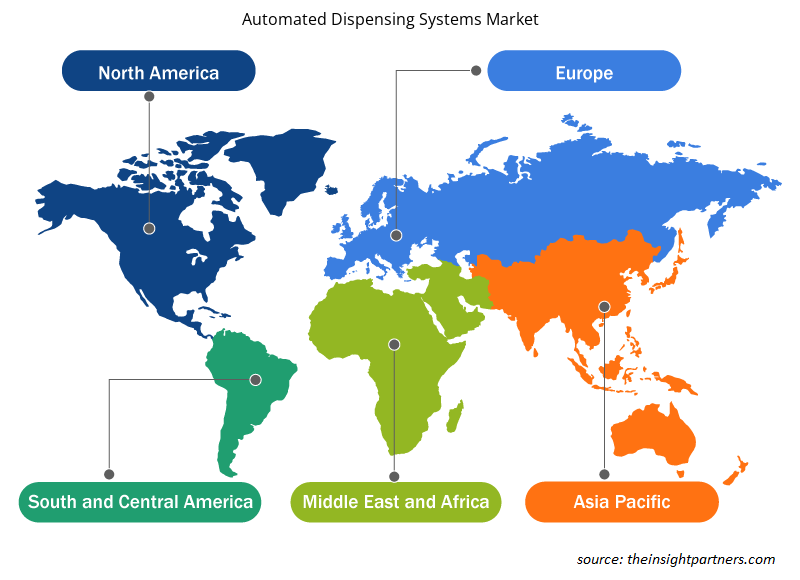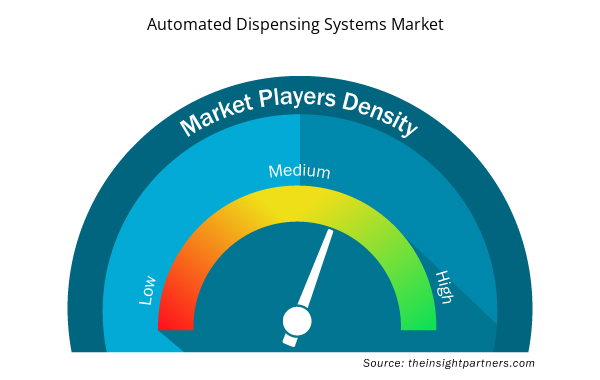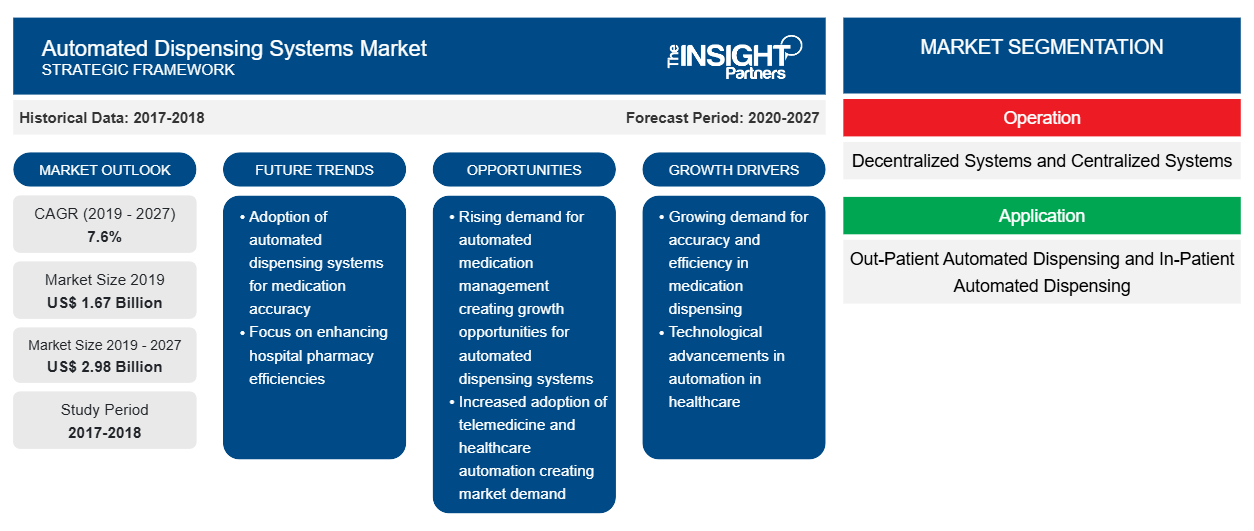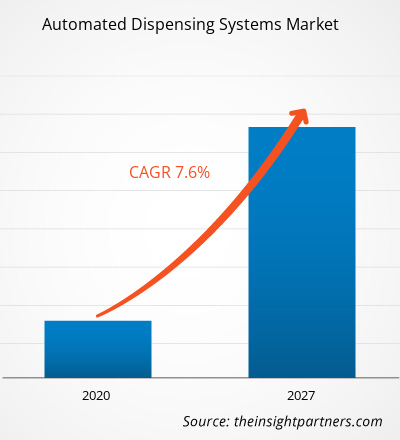Der Markt für automatisierte Abgabesysteme soll von 1.665,78 Millionen US-Dollar im Jahr 2019 auf 2.980,38 Millionen US-Dollar im Jahr 2027 anwachsen; für den Zeitraum 2020–2027 wird ein durchschnittliches jährliches Wachstum von 7,6 % prognostiziert.
Automatisierte Ausgabesysteme, auch als automatisierte Medikamentenschränke bezeichnet, sind elektronische Geräte zur Aufbewahrung und Ausgabe von Medikamenten, die hauptsächlich im Gesundheitswesen eingesetzt werden. Diese Systeme helfen bei der Verfolgung und Kontrolle der Medikamentenverteilung; sie sind mit authentifizierten Passwörtern und biometrischen Daten zur Bestandskontrolle und zum Schutz der Medikamente vor Diebstahl gesichert. Diese Systeme gelten als eines der potenziellen Instrumente zur Verbesserung der Betriebseffizienz und Patientensicherheit. Darüber hinaus werden sie heute häufig in Kliniken und Pflegeheimen eingesetzt. Automatisierte Ausgabesysteme tragen dazu bei, Krankenhäuser in sicherere, effizientere und effektivere Einrichtungen zu verwandeln.
Der globale Markt für automatisierte Abgabesysteme wird von Faktoren wie zunehmenden Medikationsfehlern und einer steigenden Zahl älterer Menschen angetrieben. Die mit automatisierten Abgabesystemen verbundenen Probleme wie falsche Programmeingaben, Geräteausfälle und andere können jedoch das Marktwachstum behindern. Darüber hinaus bieten Schwellenmärkte den Marktteilnehmern Wachstumschancen.
Passen Sie diesen Bericht Ihren Anforderungen an
Sie erhalten kostenlos individuelle Anpassungen an jedem Bericht, einschließlich Teilen dieses Berichts oder einer Analyse auf Länderebene, eines Excel-Datenpakets sowie tolle Angebote und Rabatte für Start-ups und Universitäten.
- Holen Sie sich die wichtigsten Markttrends aus diesem Bericht.Dieses KOSTENLOSE Beispiel umfasst eine Datenanalyse von Markttrends bis hin zu Schätzungen und Prognosen.
Markteinblicke
Zunehmende Medikationsfehler
Eine irrationale, unangemessene und ineffektive Medikamentenverabreichung kann zu schwerwiegenden Medikationsfehlern führen, die Patienten schaden können. Einige der häufigsten Medikationsfehler sind die Abgabe eines falschen Medikaments, die Abgabe einer falschen Medikamentenmenge, die Abgabe eines Medikaments mit falscher Stärke und das Auslassen von Artikeln. ~75 % der Medikationsfehler werden durch Ablenkung verursacht, da das medizinische Fachpersonal mit mehreren Aufgaben beschäftigt ist, z. B. der Untersuchung von Patienten, dem Sprechen mit Fachärzten, dem Sprechen mit Familienmitgliedern von Patienten oder dem Konversieren mit Versicherungsfachleuten.
Jährlich erhält die US-amerikanische Food and Drug Administration (FDA) über 100.000 Berichte über Medikationsfehler. Darüber hinaus sterben in den USA laut der im Juni 2020 in StatPearls veröffentlichten Studie „Medication Errors“ jedes Jahr etwa 7.000 bis 9.000 Menschen aufgrund von Medikationsfehlern. Ebenso kommt es laut den Schätzungen der Studie „Prevalence and Economic Burden of Medication Errors in the NHS In England“ aus dem Jahr 2018 jedes Jahr zu etwa 237 Millionen Medikationsfehlern im NHS, und vermeidbare unerwünschte Arzneimittelwirkungen (UAW) führen zu Hunderten von Todesfällen.
Betriebsbasierte Erkenntnisse
Basierend auf dem Betrieb ist der Markt für automatisierte Abgabesysteme in dezentrale und zentrale Systeme unterteilt. Das Segment der zentralisierten Systeme hatte 2019 einen größeren Marktanteil aufgrund von Faktoren wie dem wachsenden Bedarf an Kostensenkung, Sicherstellung der Medikamentenverfügbarkeit und Modernisierung der Ressourcenzuweisung. Darüber hinaus wird erwartet, dass dezentrale Systeme im Prognosezeitraum eine höhere durchschnittliche jährliche Wachstumsrate (CAGR) auf dem Markt verzeichnen werden.
Anwendungsbasierte Erkenntnisse
Basierend auf der Anwendung ist der Markt für automatisierte Abgabesysteme in die stationäre und die ambulante automatisierte Abgabe unterteilt. Das Segment der stationären automatisierten Abgabe hielt 2019 einen größeren Marktanteil; jedoch wird erwartet, dass die ambulante automatisierte Abgabe im Prognosezeitraum eine höhere durchschnittliche jährliche Wachstumsrate verzeichnet.
Endbenutzerbasierte Erkenntnisse
Basierend auf dem Endverbraucher ist der Markt für automatisierte Abgabesysteme in Krankenhausapotheken, Einzelhandelsapotheken und andere unterteilt. Das Segment der Krankenhausapotheken hatte 2019 den größten Marktanteil; es wird jedoch erwartet, dass das Segment der Einzelhandelsapotheken im Prognosezeitraum die höchste durchschnittliche jährliche Wachstumsrate (CAGR) auf dem Markt verzeichnet.
Produkteinführungen und Zulassungen sind die von Unternehmen am häufigsten angewandten Strategien, um ihre globale Präsenz und ihr Produktportfolio zu erweitern. Diese Strategien helfen ihnen, die wachsende Verbrauchernachfrage zu erfüllen. Zusammenarbeit ist eine der wichtigsten Strategien, die von den Marktteilnehmern für automatisierte Abgabesysteme angewandt wird, um ihren Kundenstamm weltweit zu vergrößern, was ihnen auch ermöglicht, ihren Markennamen weltweit aufrechtzuerhalten.
Regionale Einblicke in den Markt für automatisierte Abgabesysteme
Die regionalen Trends und Faktoren, die den Markt für automatisierte Abgabesysteme während des gesamten Prognosezeitraums beeinflussen, wurden von den Analysten von Insight Partners ausführlich erläutert. In diesem Abschnitt werden auch Marktsegmente und Geografien für automatisierte Abgabesysteme in Nordamerika, Europa, im asiatisch-pazifischen Raum, im Nahen Osten und Afrika sowie in Süd- und Mittelamerika erörtert.

- Erhalten Sie regionalspezifische Daten zum Markt für automatisierte Abgabesysteme
Umfang des Marktberichts zu automatisierten Abgabesystemen
| Berichtsattribut | Details |
|---|---|
| Marktgröße im Jahr 2019 | 1,67 Milliarden US-Dollar |
| Marktgröße bis 2027 | 2,98 Milliarden US-Dollar |
| Globale CAGR (2019 - 2027) | 7,6 % |
| Historische Daten | 2017-2018 |
| Prognosezeitraum | 2020–2027 |
| Abgedeckte Segmente | Nach Vorgang
|
| Abgedeckte Regionen und Länder | Nordamerika
|
| Marktführer und wichtige Unternehmensprofile |
|
Dichte der Marktteilnehmer für automatisierte Abgabesysteme: Verständnis ihrer Auswirkungen auf die Geschäftsdynamik
Der Markt für automatisierte Abgabesysteme wächst rasant, angetrieben durch die steigende Nachfrage der Endnutzer aufgrund von Faktoren wie sich entwickelnden Verbraucherpräferenzen, technologischen Fortschritten und einem größeren Bewusstsein für die Vorteile des Produkts. Mit steigender Nachfrage erweitern Unternehmen ihr Angebot, entwickeln Innovationen, um die Bedürfnisse der Verbraucher zu erfüllen, und nutzen neue Trends, was das Marktwachstum weiter ankurbelt.
Die Marktteilnehmerdichte bezieht sich auf die Verteilung der Firmen oder Unternehmen, die in einem bestimmten Markt oder einer bestimmten Branche tätig sind. Sie gibt an, wie viele Wettbewerber (Marktteilnehmer) in einem bestimmten Marktraum im Verhältnis zu seiner Größe oder seinem gesamten Marktwert präsent sind.
Die wichtigsten Unternehmen auf dem Markt für automatisierte Abgabesysteme sind:
- AbbVie Inc.
- Abbott
- F. Hoffmann-La Roche Ltd
- Bristol-Myers Squibb Company
- Johnson & Johnson Services, Inc.
Haftungsausschluss : Die oben aufgeführten Unternehmen sind nicht in einer bestimmten Reihenfolge aufgeführt.

- Erhalten Sie einen Überblick über die wichtigsten Akteure auf dem Markt für automatisierte Abgabesysteme
Globaler Markt für automatisierte Abgabesysteme – nach Betrieb
- Dezentrale Systeme
- Zentralisierte Systeme
Globaler Markt für automatisierte Abgabesysteme – nach Anwendung
- Automatisierte Medikamentenausgabe für ambulante Patienten
- Automatisierte Medikamentenausgabe an stationäre Patienten
Globaler Markt für automatisierte Abgabesysteme – nach Endbenutzer
- Einzelhandelsapotheken
- Krankenhausapotheken
- Sonstiges
Markt für automatisierte Abgabesysteme – nach Geografie
Nordamerika
- UNS
- Kanada
- Mexiko
Europa
- Frankreich
- Deutschland
- Italien
- Vereinigtes Königreich
- Spanien
- Restliches Europa
Asien-Pazifik (APAC)
- China
- Indien
- Südkorea
- Japan
- Australien
- Restlicher Asien-Pazifik-Raum
Naher Osten und Afrika (MEA)
- Südafrika
- Saudi-Arabien
- Vereinigte Arabische Emirate
- Restlicher Naher Osten und Afrika
Süd- und Mittelamerika
- Brasilien
- Argentinien
- Restliches Südamerika
Firmenprofile
- Cerner Corporation
- Capsa-Gesundheitswesen
- Omnicell, Inc
- BD
- ARxIUM
- Accu-Chart Plus Healthcare Systems, Inc
- Innovation Associates
- RxMedic Systems, Inc
- Swisslog Holding AG
- Willach Pharmacy Solutions GmbH
- Historische Analyse (2 Jahre), Basisjahr, Prognose (7 Jahre) mit CAGR
- PEST- und SWOT-Analyse
- Marktgröße Wert/Volumen – Global, Regional, Land
- Branche und Wettbewerbsumfeld
- Excel-Datensatz



Report Coverage
Revenue forecast, Company Analysis, Industry landscape, Growth factors, and Trends

Segment Covered
This text is related
to segments covered.

Regional Scope
North America, Europe, Asia Pacific, Middle East & Africa, South & Central America

Country Scope
This text is related
to country scope.
Häufig gestellte Fragen
The anti-viral therapiesmarket majorly consists of the players such as Cerner Corporation, Capsa Healthcare, Omnicell, Inc, BD, ARxIUM, Accu-Chart Plus Healthcare Systems, Inc, Innovation Associates, RxMedic Systems, Inc, Swiss log Holding Ltd and Willach Pharmacy Solutions GmbHamongst others.
The factors that are driving growth of the market are increasing medication errors, increasing prevalence of chronic diseases and rising geriatric population. Moreover, emerging markets is expected to offer lucrative opportunities for the growth of the market.
Automated dispensing system, also termed as automated drug cabinet, is an electronic drug storage and dispensing device primarily used in health care settings. These systems aid in tracking and controlling the drug distribution and are secured with authenticated passwords and biometrics for inventory control and security of the drugs. These systems have been recommended as one of the potential instruments to improve efficiency and patient safety, and they are now widely used in many hospitals, for instance in clinics, nursing homes. Automated dispensing system helps to transform hospitals into safer, more efficient and more effective institutions.
Trends and growth analysis reports related to Life Sciences : READ MORE..
The List of Companies - Automated Dispensing Systems Market
- AbbVie Inc.
- Abbott
- F. Hoffmann-La Roche Ltd
- Bristol-Myers Squibb Company
- Johnson & Johnson Services, Inc.
- Merck and Co., Inc.
- Gilead Sciences, Inc.
- GlaxoSmithKline plc
- Aurobindo Pharma
- AstraZeneca
The Insight Partners performs research in 4 major stages: Data Collection & Secondary Research, Primary Research, Data Analysis and Data Triangulation & Final Review.
- Data Collection and Secondary Research:
As a market research and consulting firm operating from a decade, we have published and advised several client across the globe. First step for any study will start with an assessment of currently available data and insights from existing reports. Further, historical and current market information is collected from Investor Presentations, Annual Reports, SEC Filings, etc., and other information related to company’s performance and market positioning are gathered from Paid Databases (Factiva, Hoovers, and Reuters) and various other publications available in public domain.
Several associations trade associates, technical forums, institutes, societies and organization are accessed to gain technical as well as market related insights through their publications such as research papers, blogs and press releases related to the studies are referred to get cues about the market. Further, white papers, journals, magazines, and other news articles published in last 3 years are scrutinized and analyzed to understand the current market trends.
- Primary Research:
The primarily interview analysis comprise of data obtained from industry participants interview and answers to survey questions gathered by in-house primary team.
For primary research, interviews are conducted with industry experts/CEOs/Marketing Managers/VPs/Subject Matter Experts from both demand and supply side to get a 360-degree view of the market. The primary team conducts several interviews based on the complexity of the markets to understand the various market trends and dynamics which makes research more credible and precise.
A typical research interview fulfils the following functions:
- Provides first-hand information on the market size, market trends, growth trends, competitive landscape, and outlook
- Validates and strengthens in-house secondary research findings
- Develops the analysis team’s expertise and market understanding
Primary research involves email interactions and telephone interviews for each market, category, segment, and sub-segment across geographies. The participants who typically take part in such a process include, but are not limited to:
- Industry participants: VPs, business development managers, market intelligence managers and national sales managers
- Outside experts: Valuation experts, research analysts and key opinion leaders specializing in the electronics and semiconductor industry.
Below is the breakup of our primary respondents by company, designation, and region:

Once we receive the confirmation from primary research sources or primary respondents, we finalize the base year market estimation and forecast the data as per the macroeconomic and microeconomic factors assessed during data collection.
- Data Analysis:
Once data is validated through both secondary as well as primary respondents, we finalize the market estimations by hypothesis formulation and factor analysis at regional and country level.
- Macro-Economic Factor Analysis:
We analyse macroeconomic indicators such the gross domestic product (GDP), increase in the demand for goods and services across industries, technological advancement, regional economic growth, governmental policies, the influence of COVID-19, PEST analysis, and other aspects. This analysis aids in setting benchmarks for various nations/regions and approximating market splits. Additionally, the general trend of the aforementioned components aid in determining the market's development possibilities.
- Country Level Data:
Various factors that are especially aligned to the country are taken into account to determine the market size for a certain area and country, including the presence of vendors, such as headquarters and offices, the country's GDP, demand patterns, and industry growth. To comprehend the market dynamics for the nation, a number of growth variables, inhibitors, application areas, and current market trends are researched. The aforementioned elements aid in determining the country's overall market's growth potential.
- Company Profile:
The “Table of Contents” is formulated by listing and analyzing more than 25 - 30 companies operating in the market ecosystem across geographies. However, we profile only 10 companies as a standard practice in our syndicate reports. These 10 companies comprise leading, emerging, and regional players. Nonetheless, our analysis is not restricted to the 10 listed companies, we also analyze other companies present in the market to develop a holistic view and understand the prevailing trends. The “Company Profiles” section in the report covers key facts, business description, products & services, financial information, SWOT analysis, and key developments. The financial information presented is extracted from the annual reports and official documents of the publicly listed companies. Upon collecting the information for the sections of respective companies, we verify them via various primary sources and then compile the data in respective company profiles. The company level information helps us in deriving the base number as well as in forecasting the market size.
- Developing Base Number:
Aggregation of sales statistics (2020-2022) and macro-economic factor, and other secondary and primary research insights are utilized to arrive at base number and related market shares for 2022. The data gaps are identified in this step and relevant market data is analyzed, collected from paid primary interviews or databases. On finalizing the base year market size, forecasts are developed on the basis of macro-economic, industry and market growth factors and company level analysis.
- Data Triangulation and Final Review:
The market findings and base year market size calculations are validated from supply as well as demand side. Demand side validations are based on macro-economic factor analysis and benchmarks for respective regions and countries. In case of supply side validations, revenues of major companies are estimated (in case not available) based on industry benchmark, approximate number of employees, product portfolio, and primary interviews revenues are gathered. Further revenue from target product/service segment is assessed to avoid overshooting of market statistics. In case of heavy deviations between supply and demand side values, all thes steps are repeated to achieve synchronization.
We follow an iterative model, wherein we share our research findings with Subject Matter Experts (SME’s) and Key Opinion Leaders (KOLs) until consensus view of the market is not formulated – this model negates any drastic deviation in the opinions of experts. Only validated and universally acceptable research findings are quoted in our reports.
We have important check points that we use to validate our research findings – which we call – data triangulation, where we validate the information, we generate from secondary sources with primary interviews and then we re-validate with our internal data bases and Subject matter experts. This comprehensive model enables us to deliver high quality, reliable data in shortest possible time.


 Holen Sie sich ein kostenloses Muster für diesen Bericht
Holen Sie sich ein kostenloses Muster für diesen Bericht